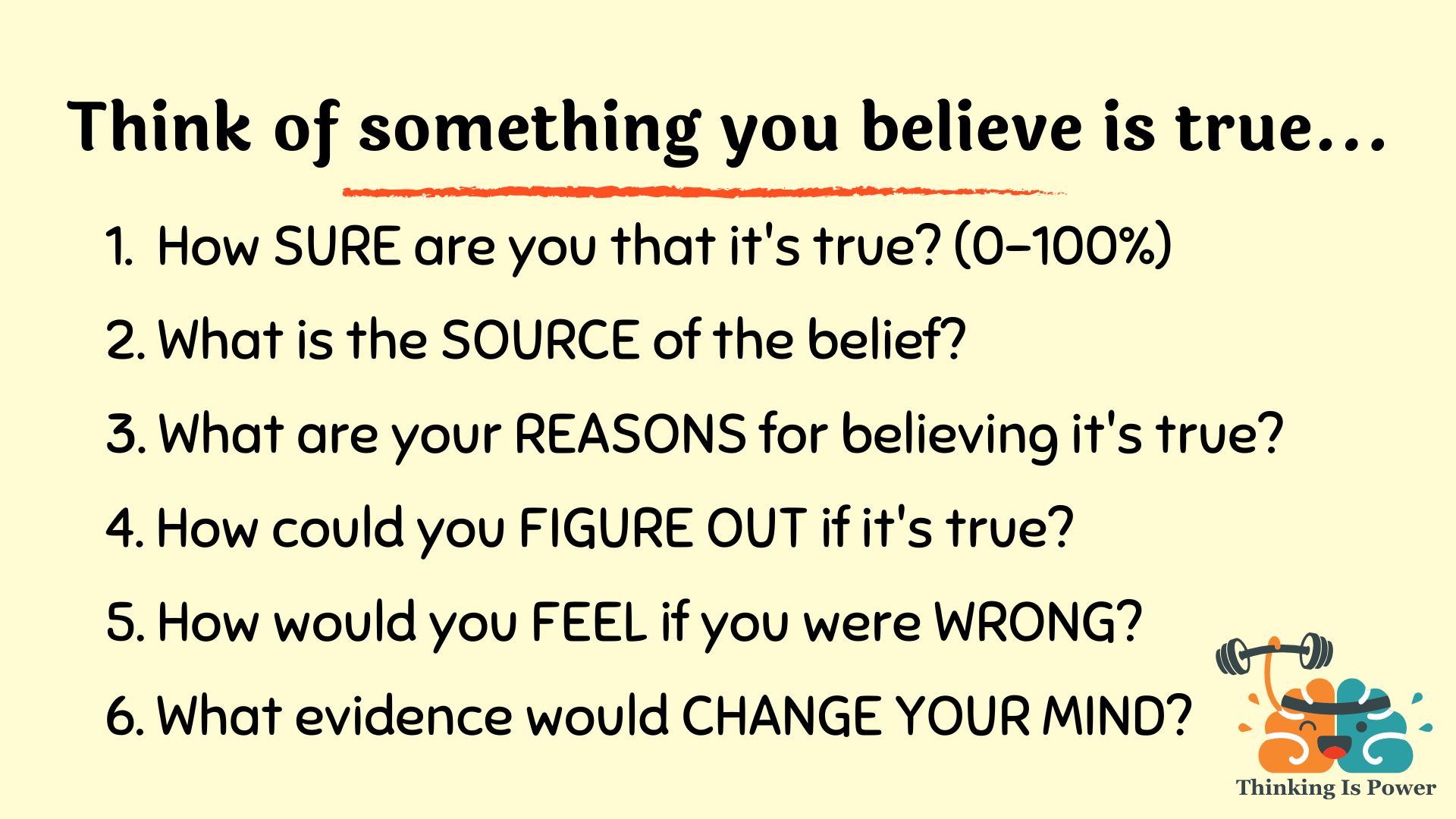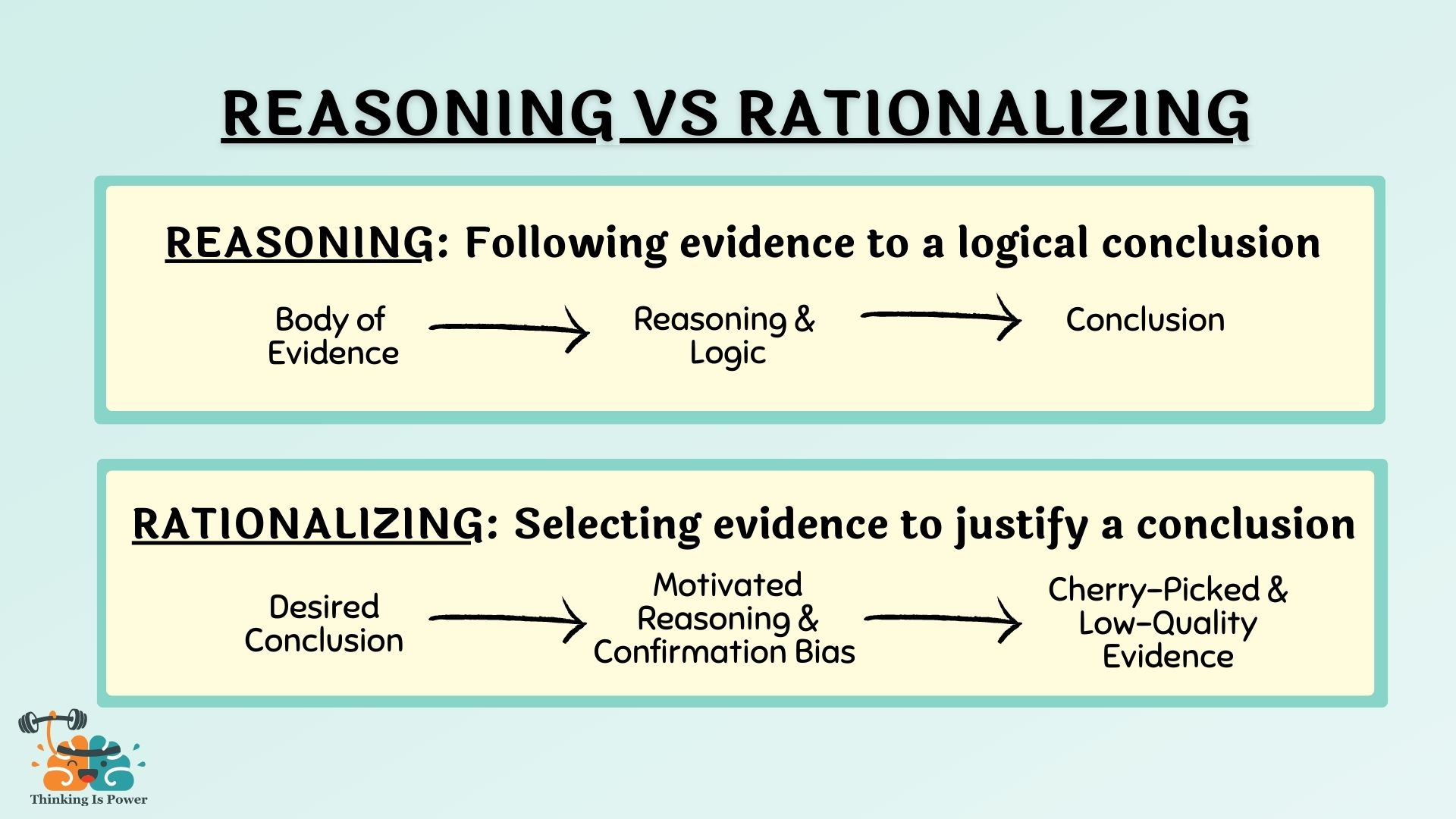Let’s try a thought experiment. Think of a belief, any belief, that you think is true. Maybe you believe psychic mediums can talk to the dead, or that immigrants bring crime to the country… or that peanut butter is the best flavor of ice cream. (It is.) It might be easier to start with a belief that’s less important to you, but it’s your choice.
Next, use the following exercise to evaluate your belief.

Thought experiment: Overview
- How sure are you that the belief is true? (0-100%): Instead of thinking that a belief is true or false, proportion your confidence along a spectrum. Put a number value on it, and try to avoid the extremes. Allow your confidence to shift with new evidence.
- What is the source of the belief?: Try to figure out where the belief came from, and be as specific as possible. Was it a personal experience? Did you hear it from someone, such as a parent or a friend? Did it come from social media or a news source?
- What are your reasons for believing?: What is the evidence for the belief? Is it sufficient? Comprehensive? Reliable?
- How could you figure out if it’s true?: Unfalsifiable beliefs – such as supernatural, vague, or subjective beliefs – aren’t testable. They aren’t necessarily unimportant, or even untrue, but they aren’t evidence-based. If the belief is falsifiable, how would you go about testing it?
- How would you feel if you were wrong?: When we want – or don’t want – to believe, we’re more likely to use motivated reasoning to deceive ourselves. So if you feel emotionally triggered to the thought of being wrong, consider that your emotions might be driving your reasoning.
- What evidence would change your mind?: As critical thinkers, we should always be willing to change our mind with evidence.
Thought experiment: Explanation
Our beliefs impact our actions and decisions, yet we often don’t think to question why we believe. More often than not, we simply believe what others around us believe, or what we’ve been told. (Our brains are often lazy and gullible.)
Once a belief is formed, we use confirmation bias to search for and favor supporting information. Maybe we’ve heard a vivid or emotional story. It’s possible we even have a personal experience of our own. After all, the best way of knowing something is to have seen or experienced it ourselves, right?!?!
Actually, our personal experiences can easily mislead us.
That doesn’t stop us from being confident, though. After all, we have “facts” and “evidence” on our side! And it sure “feels” like we know our belief is true. Those who disagree are letting their emotions get in the way of being logical. (See: Any comment section on social media!)

Source: Is a claim true? Use these four criteria to evaluate the evidence
So how would we go about figuring out if the belief is true? Evidence, of course! The trick, though, isn’t to search for evidence that supports our belief, but to look for evidence that would prove it false. If you can’t think of a way to disprove the belief, it’s untestable, and “evidence” is meaningless. It might be true, but we’ll never know for sure. But assuming the belief is testable, put on your scientist hat and actively search to prove it wrong.
The point is that evidence matters. But we’re after quality evidence, not anecdotes, unreliable “news” sites, memes, social media groups, or cherry-picked “experts.”
It’s also useful to get into the habit of proportioning our beliefs to the evidence… meaning we can be more confident a belief is true the more evidence we have, and vice versa. Overconfidence is often based on an illusion of knowledge, and it can prevent us from learning or changing our mind. Reality is complex. Embrace the shades of gray and avoid black-or-white thinking.
Learning to be skeptical of our beliefs is a difficult but essential skill. And we have to be open to changing our mind if the evidence suggests we should. It may feel like a principled stand to cling to false beliefs, or to demand impossible standards of evidence before changing your mind, but that’s the definition of denial. Just know that your inability to change your mind doesn’t make you right. And there can be serious consequences to being wrong…false beliefs can quite literally cause harm.
One more thing: Do you want to believe in things that are true, and not believe in things that aren’t? Even if it’s uncomfortable?
I’ve asked countless students this question, and they always respond with a resounding chorus of, “Of course!” But as the semester progresses, and they’re faced with questioning long-standing and identity-defining beliefs, they’re not so sure. Emotional attachment to beliefs can result us to engage in motivated reasoning and prevent us from accepting reality.
The Take-Home Message
It’s essential to get into the habit of questioning what we believe. Healthy skepticism, or demanding evidence before accepting a belief, and being open to changing our mind, is empowering. It protects us against being fooled… by others, or by ourselves.
Learn More
Street Epistemology
Orion Philosophy: The Socratic Method: How to think for yourself
Pingback: Ist wahr, was Du glaubst? 6 Fragen an dich selbst. – digitalien.org — Stefan Knecht
Great informational which increase my knowledge in term of logic thinking
Pingback: Kako vas skepticizam može zaštititi od obmane - FakeNews Tragač
Pingback: Tipps zur Faktenüberprüfung: 6 wichtige Fragen, um herauszufinden, ob deine Überzeugung stimmt
Pingback: Wie Skepsis dich davor schützen kann, getäuscht zu werden
I love this. This program should be introduced into our schools, beginning with the 6th grade, at least.
Thank you for the kind words! Obviously, I agree with you.
Melanie
Pingback: 6 WICHTIGE FRAGEN ZUR FAKTENÜBERPRÜFUNG DEINER ÜBERZEUGUNG
Pingback: 6 QUESTIONS CLÉS POUR SAVOIR SI VOTRE CONVICTION EST VRAIE
Pingback: Ist wahr, was Du glaubst? 6 Fragen an dich selbst. – digitalien
Isn’t the first exercise Bayesian theory of probability. If so perhaps an introduction to that theory would be helpful.